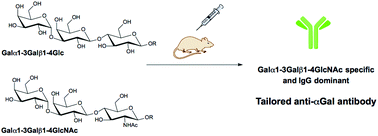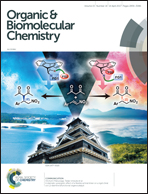The design and synthesis of an α-Gal trisaccharide epitope that provides a highly specific anti-Gal immune response†
Abstract
Carbohydrate antigens displaying Galα(1,3)Gal epitopes are recognized by naturally occurring antibodies in humans. These anti-Gal antibodies comprise up to 1% of serum IgG and have been viewed as detrimental as they are responsible for hyperacute organ rejections. In order to model this condition, α(1,3)galactosyltransferase-knockout mice are inoculated against the Galα(1,3)Gal epitope. In our study, two α-Gal trisaccharide epitopes composed of either Galα(1,3)Galβ(1,4)GlcNAc or Galα(1,3)Galβ(1,4)Glc linked to a squaric acid ester moiety were examined for their ability to elicit immune responses in KO mice. Both target epitopes were synthesized using a two-component enzymatic system using modified disaccharide substrates containing a linker moiety for coupling. While both glycoconjugate vaccines induced the required high anti-Gal IgG antibody titers, it was found that this response had exquisite specificity for the Galα(1,3)Galβ(1,4)GlcNAc hapten used, with little cross reactivity with the Galα(1,3)Galβ(1,4)Glc hapten. Our findings indicate that while homogenous glycoconjugate vaccines provide high IgG titers, the carrier and adjuvanting factors can deviate the specificity to an antigenic determinant outside the purview of interest.



 Please wait while we load your content...
Please wait while we load your content...